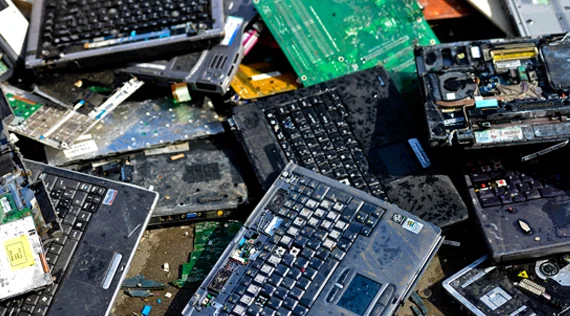
SEATTLE (Scrap Monster): EEE – electrical and electronic equipment is the pillar of our modern existence. Maybe it is also the bane of it. Our modern world would doubtlessly not function without it. We depend on our computers and phones and there is an ever-growing number of new appliances from e-bikes and e-scooters, health monitors and environmental sensors to furniture toys and even clothes with embedded electronics, electric tools, and energy-saving equipment such as LEDs, heat pumps and photovoltaics that seem to pop up regularly to make our lives more comfortable. But in the end, they go the way of all products: They end up as waste.
E-waste, basically any discarded product with a plug or battery, is the fastest-growing waste stream worldwide. Unfortunately, the global e-waste collection and recycling rate is not keeping pace with this growth.
The UN’s fourth Global E-waste Monitor (GEM) reveals staggering numbers: A record 62 million tonnes (Mt) of e-waste were produced in 2022, which means an increase of 82% from 2010. And it is estimated to rise another 32%, to 82 million tonnes, in 2030.
And just to better visualise the sheer volume: These 62 million tonnes of e-waste would fill 1.55 million 40-tonne trucks, roughly enough trucks to form a bumper-to-bumper line encircling the equator, according to the report UNITAR, the UN Institute for Training and Research and the International Telecommunication Union (ITU).
While the documented formal collection and recycling rate has gone up as well, growing from 8 billion kg in 2010 at an average rate of 0.5 billion kg per year, it lags way behind the e-waste generation. The numbers mean, that the rise in e-waste generation is outpacing the rise in formal recycling by a factor of almost 5. This is not only an environmental and public health issue – according to the report 58 thousand kg of mercury and 45 million kg of plastics containing brominated flame retardants are released into the environment every year because of non-compliant e-waste management – but also a financial one. This waste stream does not only contain hazardous but also valuable materials. Nevertheless, less than one quarter (22.3%) of the e-waste generated in 2022 was documented as having been properly collected and recycled, leaving USD 62 billion worth of recoverable natural resources unaccounted for.
“No more than 1% of demand for essential rare earth elements is met by e-waste recycling. Simply put: Business as usual can’t continue. This new report represents an immediate call for greater investment in infrastructure development, more promotion of repair and reuse, capacity building, and measures to stop illegal e-waste shipments. And the investment would pay for itself in spades,” said Kees Baldé, lead author, UNITAR.
The report also criticises that the world remains remarkably dependent on a handful of countries for rare earth elements, despite these materials' unique properties being essential for future technologies, such as renewable energy generation and e-mobility.
Valuable secondary raw materials recycled from e-waste include copper (worth $19 billion), gold ($15 billion), and iron ($16 billion). Existing e-waste management technologies can efficiently recover these metals at high rates, suggesting that improved collection rates could significantly increase value recovery. Currently, e-waste management yields $28 billion in secondary raw materials out of a potential $91 billion. Most of this is lost through incineration, landfill or inadequate treatment. The current production of secondary raw materials also prevents the extraction of 900 billion kilograms of ore.
Documented formal collection and recycling rates vary widely by region, with Europe leading the way at 42.8 per cent. However, EU Member States have made limited progress in meeting their legally binding collection targets. African countries generate the least e-waste but face significant challenges in recycling it, with rates below 1 per cent. Asia produces almost half of the world's e-waste (30 billion kg), but has made limited progress in managing e-waste, with relatively few countries having enacted legislation or set clear collection targets. In 2022, the regions generating the most e-waste per capita will be Europe (17.6 kg), Oceania (16.1 kg) and the Americas (14.1 kg). Despite having the most advanced collection and recycling infrastructure, these regions also had the highest documented collection and recycling rates per capita, with Europe at 7.53 kg, Oceania at 6.66 kg and the Americas at 4.2 kg per capita.
However, the report foresees a drop in the documented collection and recycling rate from 22.3% in 2022 to 20% by 2030 due to the widening difference in recycling efforts relative to the enormous growth of e-waste generation worldwide. The widening gap is driven by several factors, including advancements in technology, increased consumption, limited repair options, shorter product life spans, the growing electronification of society, design flaws, and insufficient e-waste management infrastructure. The report emphasizes that if countries could raise e-waste collection and recycling rates to 60% by 2030, the resulting benefits—such as reducing human health risks—would outweigh the costs, as co-author Ruediger Kuehr, Senior Manager, Sustainable Cycles (SCYCLE) Programme, UNITAR / Adjunct Professor, University of Limerick (Ireland) explained: “Improved e-waste management could result in a global net positive of USD 38 billion, representing a significant economic opportunity while addressing climate change and health impacts.”.
Courtesy: www.waste-management-world.com



| Copper Scrap View All | |
| Alternator | 0.38 (0) |
| #1 Copper Bare Bright | 4.38 (-0.03) |
| Aluminum Scrap View All | |
| 356 Aluminum Wheels (Clean) | 0.80 (-0.01) |
| 6061 Extrusions | 0.70 (-0.01) |
| Steel Scrap View All | |
| #1 Bundle | 385.00 (0) |
| #1 Busheling | 405.00 (0) |
| Electronics Scrap View All | |